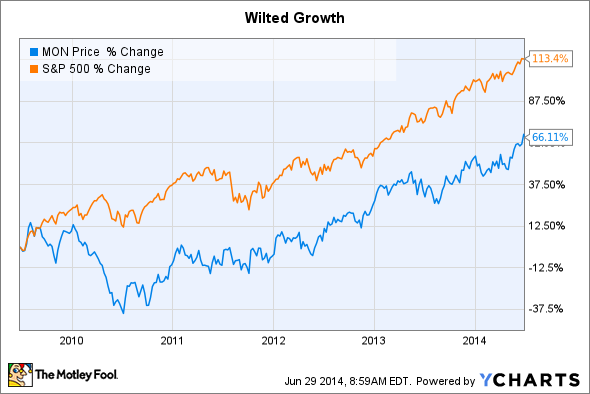Monsanto's (MON) stock price hasn't grown as much as the company would like to see. It's now taking matters into its own hands by throwing some fertilizer on its stock in an effort to push the price higher. That fertilizer is a debt fueled stock buyback that could see the company buy back as much as 15% of its outstanding shares.
Looking for a boost
For the past year Monsanto's stock has basically treaded water as it followed the market's move upward. But looking back a little further and the market is up twice as much as Monsanto's stock.
The company's stock price has lagged the market these past five years despite the fact that Monsanto's earnings have more than doubled from $2.39 per share in 2010 to over $5 per share this year. With the company now projecting that earnings will double again over the next five years it's borrowing against that future growth and adding debt to its balance sheet to buy back stock.
The plan is to grow the balance sheet from a net cash position to one that has a net-debt-to-EBITDA ratio of 1.5 times by the end of its 2015 fiscal year as the following slide shows.

Source: Monsanto Investor Presentation (link opens a PDF)
Unlike a lot of big stock buyback plans that take years to complete, Monsanto is quickly putting its plan into action. The company has already announced a $4.5 billion debt issue, which combined with the cash on its balance sheet will be used to fund the $6 billion accelerated portion of the stock buyback. From there it could issue additional debt to go along with cash generated by its business to complete the rest of the $10 billion buyback.
Plan B
Monsanto has been trying to find the right ingredients to grow its stock price as simply doubling earnings hasn't been enough to excite investors. Recently it was reported that the company explored a takeover of rival Syngenta (NYSE: SYT) according to Bloomberg. Among the benefits of the deal would be that Monsanto's tax location would move to Switzerland, which would save the company about $400 million in taxes each year. Those savings would have boosted its bottom line so that its earnings would have grown even faster.
Tax advantages aside, a deal with Syngenta would have also created the world's biggest agricultural company. It would have combined Monsanto's lead in seeds with Syngenta's lead in crop chemicals. It's a combination that could have unlocked a lot of value as estimates suggest that synergies from the combination would have saved the combined company as much as $600 million and boost earnings per share by as much as 16% by 2016. But at this point a deal isn't likely so Monsanto needed to do something else to juice its earnings per share above what its organic growth prospects would yield.
In using debt to buy back its stock the company can reduce its share count by as much as 15%. This would enable its future earnings growth to be spread across fewer shares. In that sense it would have had a similar effect as a merger with Syngenta.
Investor takeaway
Monsanto's stock price hasn't been growing as fast as its earnings so the company has been exploring the best way to throw a bit of fertilizer on its stock to produce more growth. After a deal with Syngenta didn't make it past initial discussions, the company is simply going to take matters into its own hands and buy back its stock by taking on some debt. It's a move that could be just the fertilizer the company's stock needs to start growing.






